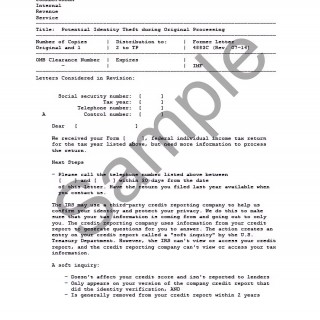IRS Letter 4883C. Potential Identity Theft During Original Processing
IRS Letter 4883C is a letter sent by the Internal Revenue Service (IRS) to taxpayers to verify their identity. The main purpose of this letter is to prevent tax fraud and identity theft by ensuring that the taxpayer is the rightful owner of the Social Security number used on their tax return.
The title of IRS Letter 4883C is "Potential Identity Theft During Original Processing". The letter is sent to taxpayers when the IRS has reason to believe that their identity may have been stolen or compromised during the processing of their tax return.
The IRS generates this letter as part of its efforts to prevent tax fraud and identity theft. The agency uses a variety of methods to identify potential instances of fraud, including reviewing tax returns for inaccuracies or inconsistencies, analyzing patterns of behavior, and comparing information provided on tax returns with information from other sources such as employers and financial institutions.
If the IRS suspects that a taxpayer's identity may have been stolen, they will send Letter 4883C requesting that the taxpayer verify their identity. The letter provides instructions on how to do so and may require the taxpayer to provide additional documentation such as a copy of their driver's license or passport.
It is important for taxpayers to respond promptly to Letter 4883C and provide the necessary information to verify their identity. Failure to do so may result in delays in receiving tax refunds or other penalties.
The letter consists of a greeting, an explanation of why the letter was sent, instructions on how to verify identity, and a deadline for responding. It is important to read the letter carefully and follow the instructions provided.
The parties involved in the letter are the IRS and the taxpayer who received the letter. When completing the form, the taxpayer will need to provide personal information such as their name, Social Security number, and date of birth. Additionally, the taxpayer may be required to provide documentation such as a copy of their driver's license or passport to verify their identity.
Strengths of this form include its ability to prevent tax fraud and identity theft, while weaknesses may include the inconvenience of having to verify identity and the potential for delays in receiving tax refunds. Opportunities include the ability to catch and prevent fraudulent activity, while threats may include the potential for fraudsters to steal personal information.
There are no related or alternative forms to this letter, as it is a unique letter sent by the IRS. However, taxpayers can take steps to prevent identity theft by monitoring their credit reports and being vigilant about protecting their personal information.
To fill and submit the form, the taxpayer will need to follow the instructions provided in the letter and provide the necessary personal information and documentation to verify their identity. The form will be stored by the IRS for record-keeping purposes.
After receiving the letter, the taxpayer should respond promptly and provide the necessary information to verify their identity. Failure to respond to the letter may result in delays in receiving tax refunds or other penalties. The taxpayer should also take steps to protect their personal information and monitor their credit reports for signs of fraudulent activity.

